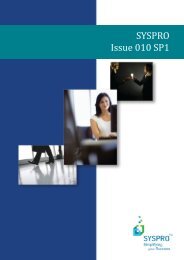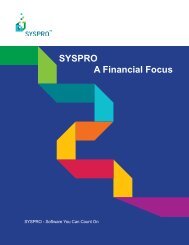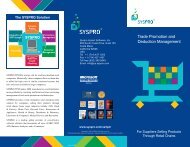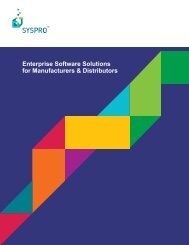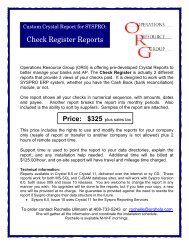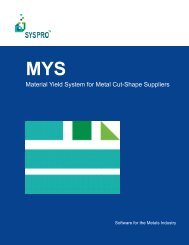Teach Yourself e.net - Syspro
Teach Yourself e.net - Syspro
Teach Yourself e.net - Syspro
Create successful ePaper yourself
Turn your PDF publications into a flip-book with our unique Google optimized e-Paper software.
The Class Library Reference<br />
End Try<br />
Response.ContentType = "text/xml"<br />
Response.Write(XmlOut)<br />
Response.End()<br />
' Logoff and Cancel your current Session<br />
Dim ReturnCode As Long<br />
ReturnCode = Obj.Logoff(UserId)<br />
Setup = Nothing<br />
Obj = Nothing<br />
5.4. Transaction Class<br />
The Transaction class has two Methods with it's class structure: Post, and Build.<br />
Use the e.<strong>net</strong> Diagnostics suite's Harness tool to see the method options displayed when<br />
you select the Transaction class:<br />
By selecting each different method and clicking on the business object drop down menu<br />
you can see which business objects are available for that particular method within the<br />
Setup class.<br />
5.4.1. Transaction.Post<br />
Syntax:<br />
Utilities.Transaction(UserID, BusinessObject, XmlParameters,<br />
XmlIn)<br />
The Post method enables transactions to be posted to SYSPRO.<br />
The return XML string will indicate success or failure. More complex Post methods will<br />
use the Build method to assist with building the XML data.<br />
The Transaction.Post method requires two XML input strings. The first,<br />
XmlParameters is used to pass parameters to the Business Object. The second, XmlIn<br />
contains the data to be posted to SYSPRO. The Business Object will return an XML string<br />
indicating success or failure.<br />
The structure and parameters allowed in XmlParameters and XmlIn is dependent on<br />
the business object being called.<br />
5–37



